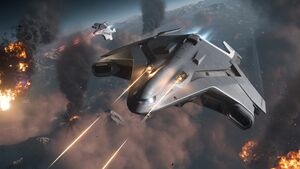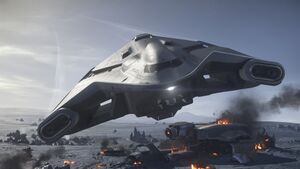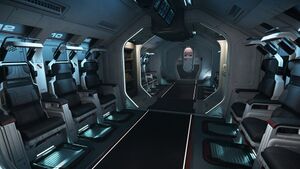No edit summary |
|||
| Line 1: | Line 1: | ||
[[File:M2-herc-flying.jpg|thumb]] | |||
[[File:M2-herc-head.jpg|thumb]] | |||
[[File:M2-herc-int.jpg|thumb]] | |||
The Hercules Class Starship is a feat of compact engineering and sophisticated automation spread across two efficiently designed decks. Its large cargo bay caters to extensive resource requirements, while its auxiliary vehicles, including a small shuttle and an armored ground transport, facilitate diverse mission profiles. This vessel's high level of automation is achieved through the integration of a [[Mark 1 Active Repair System]], autonomous droids, and a Master Systems AI, which together ensure optimal operation and maintenance even with a minimal crew complement. The Hercules Class Starship represents a pragmatic, technically advanced approach to long-term exploration and reconnaissance in the vast expanse of space. | The Hercules Class Starship is a feat of compact engineering and sophisticated automation spread across two efficiently designed decks. Its large cargo bay caters to extensive resource requirements, while its auxiliary vehicles, including a small shuttle and an armored ground transport, facilitate diverse mission profiles. This vessel's high level of automation is achieved through the integration of a [[Mark 1 Active Repair System]], autonomous droids, and a Master Systems AI, which together ensure optimal operation and maintenance even with a minimal crew complement. The Hercules Class Starship represents a pragmatic, technically advanced approach to long-term exploration and reconnaissance in the vast expanse of space. | ||
; Dimensions : 73 x 55 x 18 m | ; Dimensions : 73 x 55 x 18 m | ||
; Crew Capacity : 3 (1 Minimum) | ; Crew Capacity : 3 (1 Minimum, 50 Evacuation Capacity) | ||
; Power Source : Deuterium Fusion Reactors (5)<br>Matter / Antimatter Reactor | ; Power Source : Deuterium Fusion Reactors (5)<br>Matter / Antimatter Reactor | ||
; Propulsion : [[Impulse Drive]]<br>[[Dimensional Fold Drive]]<br>[[Warp Drive]]<br>Jump Point Generator | ; Propulsion : [[Impulse Drive]]<br>[[Dimensional Fold Drive]]<br>[[Warp Drive]]<br>Jump Point Generator | ||
| Line 16: | Line 19: | ||
* Holographic Hull Markings | * Holographic Hull Markings | ||
* Deflector Shields | * Deflector Shields | ||
* [[ | * [[Phasing Cloak]] | ||
== Auxiliary Systems == | == Auxiliary Systems == | ||
Revision as of 00:07, 9 June 2023



The Hercules Class Starship is a feat of compact engineering and sophisticated automation spread across two efficiently designed decks. Its large cargo bay caters to extensive resource requirements, while its auxiliary vehicles, including a small shuttle and an armored ground transport, facilitate diverse mission profiles. This vessel's high level of automation is achieved through the integration of a Mark 1 Active Repair System, autonomous droids, and a Master Systems AI, which together ensure optimal operation and maintenance even with a minimal crew complement. The Hercules Class Starship represents a pragmatic, technically advanced approach to long-term exploration and reconnaissance in the vast expanse of space.
- Dimensions
- 73 x 55 x 18 m
- Crew Capacity
- 3 (1 Minimum, 50 Evacuation Capacity)
- Power Source
- Deuterium Fusion Reactors (5)
Matter / Antimatter Reactor - Propulsion
- Impulse Drive
Dimensional Fold Drive
Warp Drive
Jump Point Generator - Cruising Speed
- Warp 4.5 / Fold 6.3
- Maximum Speed
- Warp 7.9 / Fold 9.12
- Emergency Speed
- Warp 8.24 for 30 Minutes / Fold 9.47 for 12 Minutes
Offensive Systems
- Phaser Emitters (4 Dorsal / Fore)
- Photon Torpedos (2 Dorsal / Fore)
Defensive Systems
- Holographic Hull Markings
- Deflector Shields
- Phasing Cloak
Auxiliary Systems
- Master Systems AI with Holographic Interface as well as XIA Body and Mark I Humanoid Android Body
- Astromech Droids (15)
- Teufel Probes (23)
- Mark 1 Venture Transport
- Type 7 Shuttle Craft
History
The genesis of the Hercules Class Starship is a tale steeped in interstellar cooperation, technical ingenuity, and a relentless pursuit of perfection. It all began in 2382 when Solas Tempus proposed the idea of an advanced, compact exploration vessel. Recognizing the potential of this innovative concept, Starfleet Command agreed to contribute their extensive design and engineering expertise to the project.
Just two short years later, in 2384, the partnership bore its first fruits: a series of state-of-the-art prototypes that encapsulated the ambitious vision behind the Hercules Class Starship. However, differing views on the final design led to an amicable split between Starfleet and Solas Tempus. Each organization chose to adopt a distinct final design that best served their respective needs and ideologies.
Solas Tempus dedicated the next three years to perfecting their unique design, incorporating breakthrough propulsion technologies such as the Dimensional Fold Drive (DFD) and the Hyperspace Jump Point Generator. Their commitment to innovation and precision was evident as they tirelessly refined and improved upon their design, culminating in a near-perfect prototype by 2387.
However, the relentless pursuit of perfection did not stop there. During rigorous defensive testing in 2388, it became evident that the ship's defensive capabilities fell short of the high standards set by Solas Tempus. True to their meticulous approach, they responded by enhancing the ship's weapon systems, bolstering its ability to stand its ground in even the most hostile of environments.
Thus, the Hercules Class Starship as we know it today was born, reflecting the dedication, innovative spirit, and relentless pursuit of perfection that define both Starfleet Command and Solas Tempus. Whether exploring uncharted territories or navigating diplomatic intricacies, the Hercules Class Starship stands ready to face the challenges of the final frontier.